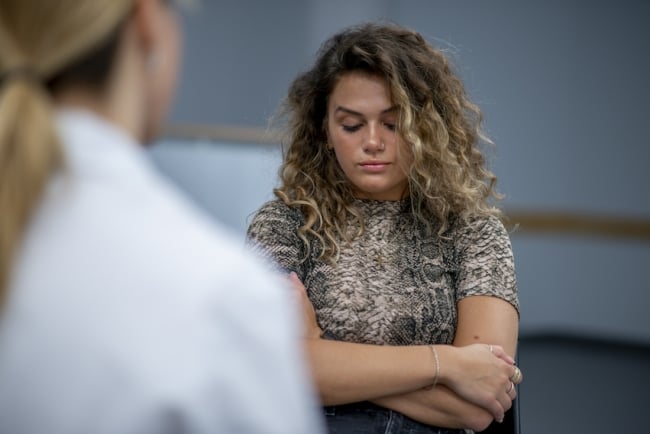You have /5 articles left.
Sign up for a free account or log in.

In some cases, mental health accommodations include “release time” for students to meet with therapists and psychiatrists.
FatCamera/E+/Getty Images
The University of California, San Francisco, recently made a new accommodation available to students with disabilities: “release time” to attend medical appointments.
“Very often that is therapy,” said Tim Montgomery, director of student disability services at UCSF. “But we don’t say therapy; we just say ‘medical appointments’ and leave it at that.”
Like many postsecondary institutions around the country, UCSF is seeing a spike in students registering with disability services to receive accommodations for mental health conditions. At UCSF, which enrolls about 3,200 students in health-related professional and graduate programs, about 14.5 percent of students are registered with disability services, Montgomery said. Nearly 70 percent of those are new to his office.
“Our two biggest areas are mental health and learning disabilities,” Montgomery said.
Letter to the Editor
A reader has submitted
a response to this article.
You can view the letter here.
Find all our Letters
to the Editor here.
While students are encouraged to schedule medical appointments outside school hours, that’s not always possible. So, a year or two ago, the university started offering release time to allow students to keep their therapy and psychiatric appointments without being penalized for missing class or labs.
Montgomery said the accommodation was conceived partly in response to two student deaths over the past two years.
“That’s happening across the country,” he said. “It’s not just UCSF.” And going through such anguish makes colleges “much more tolerant of that accommodation.”
The national mental health crisis gripping postsecondary institutions has led to an uptick in students registering with campus disability support offices to receive accommodations for psychological disorders. While no national organization tracks college students’ disabilities by type, data from a handful of individual institutions—combined with empirical and anecdotal evidence from others—show that the proportion of students registering for accommodations for psychological disabilities is growing faster than almost any other group seeking accommodations.
At Texas A&M University, the total number of students registered for disability services rose from 897 in 2010 to 2,840 in 2020; during that same period, those who registered for mental health accommodations more than quadrupled, from 248 to 1,178.
The share of students registered with Purdue University’s disability resource center grew from about 2.4 percent of the total student population during the 2014–15 academic year to 6 percent in 2020–21. At the same time, the number of students whose primary disability was listed as a “psych condition” jumped more than fourfold, from 179 to 755.
In the 23-campus California State University system—the nation’s largest, with more than 477,000 students—the share of enrolled students registered with disability services has inched upward, from 2.6 percent in 2010 to 4.4 percent in 2021, according to data shared with Inside Higher Ed. Meanwhile, the proportion of those students with psychological and psychiatric conditions has skyrocketed, from 6 percent in 2010 to 29 percent last year.
“The number of students seeking mental health accommodations has been climbing steadily, even before the pandemic, but the pandemic certainly has exacerbated it,” said Ray Murillo, director of student programs in the chancellor’s office at CSU.
In addition, Murillo said, the level of severity has increased.
“We have many students that will end up enrolling for the first time on our campuses who have already been working with a psychiatrist and already medicated given their psychological or psychiatric disability, but also have been previously hospitalized, which we definitely weren’t seeing five or 10 years ago,” he said.
Flexible Attendance
Under the Americans With Disabilities Act, colleges and universities are required to provide “reasonable accommodations” to students with disabilities. For those with registered mental health conditions, accommodations often center on flexible attendance.
At Ohio State University, the 10 to 11 percent of students registered for accommodations includes a significant share with chronic psychological issues, said Scott Lissner, OSU’s ADA coordinator and 504 compliance officer.
“With the increase in the proportion of our students with mental health conditions, we see more requests for a part-time workload, more needs for accommodations around attendance and deadlines,” he said.
Students come in with requests like, “I need an easier path to taking a leave of absence because I ran into a more extreme episode this semester,” he said. “I need that extra flexibility to either miss more classes, or it may be that that some remote participation is a way of helping compensate for the fact that I can’t get out of bed.”
Lissner is working to make changes so that students who receive a reduced course load as an accommodation don’t lose Pell Grant money, which is scaled according to number of credits.
Point Park University in Pittsburgh has added more academic coaching to its services.
“Students who are experiencing mental health challenges tend to have trouble with executive functioning skills like time management, prioritization and focus,” Molly McClelland, director of Point Park’s center for student success, wrote in an email. “Our academic coaches give students a sense of accountability and sense of belonging.” They’ve also helped boost retention rates, she said.
Requests for accommodations at Point Park, which enrolls about 3,500 undergraduates, have nearly doubled since the 2017–18 academic year; out of 480 requests this academic year, 168—35 percent—were associated with mental health needs, McClelland wrote. Of those, 83 students registered for anxiety and panic disorders as their primary disability, and 48 registered for depression.
McClelland noted that “the majority of students who receive accommodations for mental health diagnoses receive extended time on assignments and exams, as well as testing in an undistracted environment.”
Researchers point out that extra time is generally useful to all students—even those without disabilities—but it’s especially beneficial to those with learning disabilities. As for those with mental health conditions, there’s simply not enough evidence yet to say whether extended time makes sense as an accommodation, said Ben Lovett, a psychologist and professor at Teachers College of Columbia University.
“We don’t have direct research on students with anxiety or depression or disorders like that,” he said. “The closest that we’ve come is researching their diagnostic skills like processing speed, working memory, reading speed and things like that. That research, even though it’s indirect, has generally shown most students who have those sorts of more emotional problems don’t usually seem to lack the skills needed to take a test. The test might be unusually uncomfortable for them, they might feel distressed during a test, but it doesn’t really seem to impact their ability to access the test, which is the key legal standard for an accommodation.”
History of Accommodations
In 2012, the Association of Higher Education and Disability (AHEAD) issued new guidance to help colleges and universities manage accommodation requests in compliance with the ADA, which recently had been amended to establish a broad definition of disability as a “physical or mental impairment that substantially limits one or more major life activities.”
The AHEAD guidelines cited three types of recommended documentation to support the granting of accommodations: primary, which is the student’s self-report of their disability; secondary, which is “observation and interaction” by campus disability professionals; and tertiary, or information from third parties, such as doctors or teachers.
The tiered recommendations have contributed to a great deal of uncertainty and inconsistency in how institutions navigate accommodation requests, with some relying on the student’s word above all else.
The emphasis on self-reported data “was designed specifically to increase students’ access to services,” said Bob Weis, a clinical psychologist at Denison University. “It was well-intentioned because there are some students who couldn’t get a doctor’s note or they couldn’t afford psychological testing, or they went to lower-income high schools and they don’t have the school documentation that other kids have. But I think the pendulum may have swung too much in the opposite direction now, where in some cases, there really aren’t clear guidelines as to what sort of documentation, if any, students need to provide to get services.”
Lissner, who helped write the AHEAD guidance, said the three types of documentation were not intended to be a hierarchy.
“I’m the one who came up with primary, secondary and tertiary,” he said. “I thought I was being clever and speaking a language that academics would understand, and it did muddy the waters. It was perhaps not the best choice.”
Lissner doesn’t regret the intent of the language, which was to let individuals determine whether they have a disability—but not necessarily whether they get an accommodation.
“If you want to claim disability, more power to you. I promise to not harass you, bully you, tease you or discriminate against you because you claim disability as part of your identity,” he said. “Now, if you want double time on tests, I need a little information I can’t observe directly.”
That’s where reports from doctors, social workers, teachers or even parents and friends should be used.
Faculty Response
Most students who register with disability support offices receive accommodations. According to a recent report from the National Center for Education Statistics, 85 percent of students at four-year institutions who reported a disability received an accommodation, though just 53 percent of those at two-year colleges did the same.
On the record, at least, faculty are stoic and supportive in granting accommodations, exhausted but genuinely concerned about their students and willing to do whatever it takes to help them succeed.
But privately, some acknowledge the increase in accommodation requests is exacerbating the burnout they already feel.
“Faculty don’t have much control about determining whether an accommodation is appropriate,” said Weis, the Denison psychologist. “It’s rare that a faculty member can say, ‘You know, this actually would violate some standard of my course.’ But at times faculty become skeptical or I think just are a little surprised at the numbers of students who have disabilities, accommodations.”
Asked about the increase in requests for mental health accommodations, one adjunct professor at a small liberal arts college in New Jersey, who requested anonymity to speak freely, wrote, “I get more and more of those every class I teach!! I understand there may be a very tiny number of some accommodations that are indeed appropriate but they are really being abused at this point (in my own humble opinion).”
The professor cited recent high-profile deaths by suicide among student athletes as cautionary.
“The sad thing is that this is real,” the professor wrote. “On the other hand, there are so many more cases where the students get away with things they shouldn’t … drawing the line is tricky and nobody wants to make a mistake and god forbid something unexpected happens.”
Universal Design for Learning
For psychological disabilities in particular, accommodations should be seen as a temporary solution, said Weis.
“Accommodations are good and appropriate for people with those conditions,” he said. “But we ought not lose sight of treatment. I mean, anxiety, depression and ADHD are treatable conditions. What we really want to do is say, ‘Let’s use accommodations until you can treat this condition through therapy and/or medication.’ We don’t want people saying, ‘I’m just going to rely on accommodations for the next six months or eight months or forever.’”
Disability rights advocates argue that in the long term, the goal should be to transform teaching and learning enough so all students can access them. If more professors adopted universal design for learning—which respects the needs and abilities of every student, allowing them both to acquire and demonstrate knowledge in their own way—it might eventually make many disability accommodations obsolete, said Amanda Kraus, executive director for disability resources and chief accessibility officer at the University of Arizona, who currently serves as the president of AHEAD.
“The problem is the system, right? The problem is higher ed; the problem is curricular design. It’s not the student,” she said. “So at the end of the day, if faculty take a more progressive kind of universal design approach to their teaching, that will certainly reduce the need for accommodation. And it would probably benefit everyone.”








